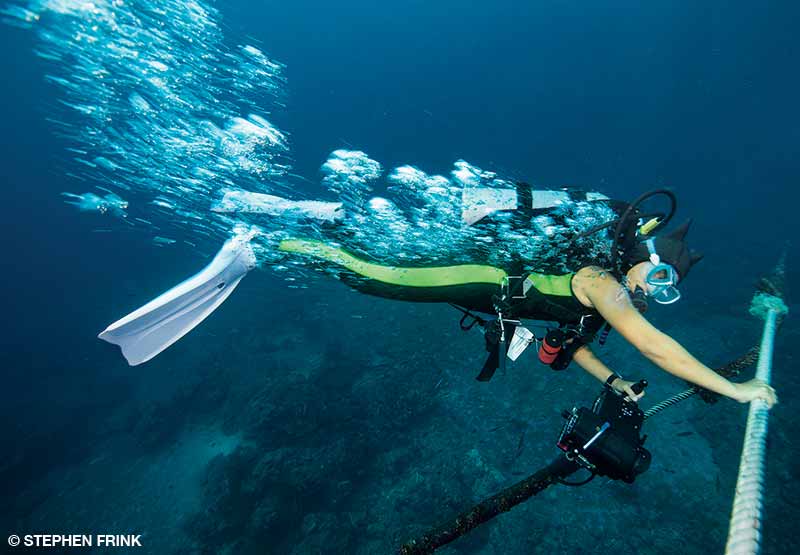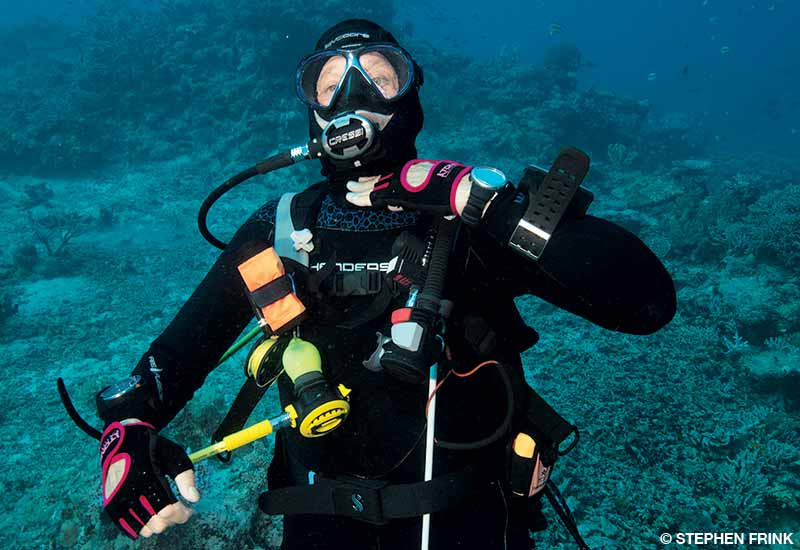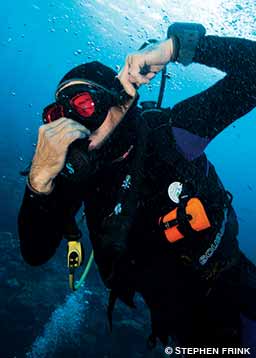By all accounts the conditions looked great for a staff training dive in Fort Lauderdale, Florida. The swells were 2 to 3 feet, the sun was shining, and the water was 84°F. The staff divemasters and instructors from the Nova Southeastern University Academic Diving Program (NSUADP) gathered for the briefing. “Our objective today is carbon dioxide minimization,” I said to my team as they all eagerly leaned in for more explanation.
Every semester the NSUADP staff of 20 divemasters and instructors train in the environments they frequent — pool, lake, beach and charter boat dives. The training scenarios are as realistic as possible so that every staff member leaves the training more confident in their skills. This professional development anchors a strong culture of safety in the organization.
This day’s training dive was unique in a new way — we were going deep. Because of the target depth of 120 feet, there were no surprise scenarios, just a familiar task and an objective. We would descend the downline tied off at a wreck, where each diver would do a neutrally buoyant mask swap with their buddy. After the exchange, a proper ascent with a safety stop would end the dive.
The objective for this training dive was to perform the mask swap while keeping carbon dioxide (CO2) production to a minimum. Divers would accomplish the task by being efficient with their underwater movements and maintaining proper trim, weighting and positioning during the skill to avoid fighting the current.

Taxing your body with activity uses more oxygen and produces more of the metabolic product CO2. This leads to increased respiration, which in turn reduces the amount of time a diver can spend underwater. If CO2 levels increase too much, the diver can experience fatigue, exhaustion, anxiety and the feeling of air starvation. Elevated CO2 levels can ultimately lead to hyperventilation, panic, rapid ascent, and even unconsciousness and seizures.
After I explained the dive plan and objective, I encouraged the staff to visualize several versions of the dive that included good and bad visibility and current. Visualizing bad conditions helps prepare divers to confront those conditions without surprise.
The Dive
The charter’s divemaster ascended the dive ladder and briefed our team. “You have a strong north current at the surface, and it’s consistently strong all the way to the wreck,” he stated. I reminded everyone to continue visualizing a strong current and pulling hand over hand down the line while keeping their breathing in check.
From the dive platform I could tell by the downline’s hard angle that the current was indeed strong. It hit me as soon as I entered the water, sending me backward, so I broadened my kick and tucked my head to streamline and power hard to the line. I was already winded by the time I reached it.
The combination of heavy wave action and the large float ball in my way prevented me from warning the others to kick hard and get trim as soon as they entered the water. While I pulled down to 20 feet, I repeatedly glanced up to check on my team. One by one, I watched them struggle as I had. Every turn of my head tugged my mask to the point of leaking. I remember thinking, “This is why we train our students to perform both two-handed and one-handed mask clears.” I rolled on my back to keep the team in sight, one hand holding my mask in place and the other tightly gripping the line.
The divers were organized and spaced perfectly apart on the line, but their arms were nearly straight. They also were repeatedly clearing their masks and holding them on. Continuous, heavy bubble trails were billowing behind each diver. I realized then I was breathing much heavier than normal, so we were already dealing with high CO2 levels just minutes in and only 20 feet down. Stopping to catch our breaths would not resolve it, as the current would be this strong down to the wreck. It was time to abort the objective and to call the dive.

Calling the Dive
I turned to my team and reached out high and wide with a thumbs-up signal. In unison, they returned the signal and began dealing with a set of unexpected challenges. In reverse order from the instructor closest to the boat, they had to swim from the line to the dive platform. Even at only 7 feet, the swim was tremendously difficult. Without perfect timing, we risked tumbling under the boat and possibly contacting the rudder or propellers.
The first instructor made it to the ladder but had to fight to hang on as his feet were swept under the stern. With all his might, he pulled himself onto the ladder. The current pinned him to the ladder, and he was struggling against the relentless pressure. Both divemasters on the boat were kneeling on the platform and tightly holding the instructor as he ascended.
What should have taken each person only 30 to 45 seconds — swimming to the ladder, removing your fins and walking up — instead took two to three minutes. We watched as everyone struggled to get back on board. This situation was not safe. But since I was first in, I was last on the line and could not simply pop up my head and ask the captain if we could all let go and drift. Besides, that scenario immediately brought other concerns to my mind. Would it present a whole new set of challenges and risks? How could we let go safely and not inadvertently travel under the boat?
Finally at the surface, my head bobbed with each wave. I caught glimpses of the captain and divemasters helping the diver on the ladder. One divemaster was lying on his stomach with his arms under the platform, helping the instructor before me. Whenever a big wave came, the divemaster’s head went underwater. Duty-bound, he diligently held onto the diver in his care.
When the ladder was available, I let go of the line and swam toward it. My collision with metal rungs was sobering. Pinned against the ladder and moving in slow motion, I thought about each staff member before me and how they also struggled here. When I made my way up, I noticed the weakness in my hands from gripping the line for so long. I heard my regulator’s high-pitched whine and realized how heavily I was breathing.
Once back at my seat, I plopped down in exhaustion. I looked around to account for each team member. They were all there, mouths open, leaning forward and breathing heavily. Few words other than an occasional “Wow!” or something more colorful broke the heavy breathing. Soon after, the stories of how challenging it had been getting back to the boat started pouring out, and it was the perfect time for a debrief with my team and the boat crew.
Lessons Learned
As a seasoned dive professional, I have dived in currents of all varieties. This day’s current wasn’t the strongest one I have ever encountered, so why did we end up having to call the dive?

During our debrief we realized that although the divemaster knew the current was strong, he considered that the entire boat was a private charter for only our divemasters and instructors. We all had the talents and capabilities to perform the dive by his assessment, and he was right. But he did not know our objective for the dive.
We also realized that we had not proactively communicated the procedures to call the dive. Calling a dive is not as easy as just giving the thumbs-up signal. There are steps to follow after the signal to cancel a dive. The dive briefing should cover these procedures, and the greater the dive’s potential risk, the more attention to detail the procedures and briefing should have to make calling the dive happen as safely as possible.
It was important for everyone to acknowledge why we had never had a problem like this before. This dive boat usually hooks up to a wreck and ties the descent line onto one of the rear cleats. That position makes it easy for divers to enter the water from the dive platform and quickly get onto the descent line. Once all the divers are in, the crew moves the line to the bow. The boat will then turn around so divers surfacing will float toward the back of the boat, grab the tag line and pull themselves to the ladders with ease. Because we called the dive so early, the boat had not yet turned around into position. The approach we had to take to board was not the standard procedure, especially in such a strong current.
The captain suggested that if we recognize on a future dive that negotiating the ladders would be challenging to the point of hazardous, it would be better to avoid the ladders altogether. He recommended swimming hard away from the line and boat to ascend and wait in a group with surface marker buoys deployed until the boat can unhook and get us.
Our team learned vital lessons about communicating objectives to the boat crew and planning procedures if we needed to call the dive. These lessons permeated our dive program at the staff level and with our students. We now teach why and how to call the dive — any dive, by any diver and for any reason.
Some Tenets of Calling a Dive
General Rule: Anyone can cancel any dive, at any time, for any reason.
Common reasons for canceling dives
- Environmental: Environmental conditions can dramatically affect dive activities. A variety of environmental factors, predominantly weather, can cause currents, visibility, temperatures and wave action to be considerations you must make before and during a dive. Conditions can change quickly and can negatively impact planned dives.
- Personal health: The physical and mental well-being of a diver is vital to safe diving. Sinus or lung congestion is a big one, but other physical aches and pains can be disabling and distracting. Divers must maintain mental focus on the dives and their dive buddies. Distraction causes errors and lapses in judgment that can lead to major incidents.
- Equipment: Divers rely on properly functioning life-support equipment. A sticking pressure gauge, a dive computer with a low battery or a small stream of bubbles coming from a bad O-ring can all become quite problematic, even to the point of creating a dangerous situation while underwater.
- Gut feeling: Trust the gut feeling that tells you something is not right. You may not be able to pinpoint the issues, but your brain subconsciously reacts to them. Your instinct is trying to tell you something.
How to call a dive
- Discuss the possibility of calling a dive as part of every dive briefing. State the general rule, and discuss the signals you will use to call the dive. Provide instructions for how to return to the surface and the boat or shore after someone gives the signal.
- Ensure everyone knows what signal to use when calling the dive underwater. A common one I use is to cross both forearms in front of you to resemble the letter X. Accompany the crossed forearms with the thumbs-up signal, and be sure to differentiate it from the sign for “cold.” If one hand is occupied with holding a line or a piece of equipment, a simple thumbs-up signal will work to end the dive by ascending. Be sure to discuss all signals in the dive briefing.
© Alert Diver — Q3/Q4 2021